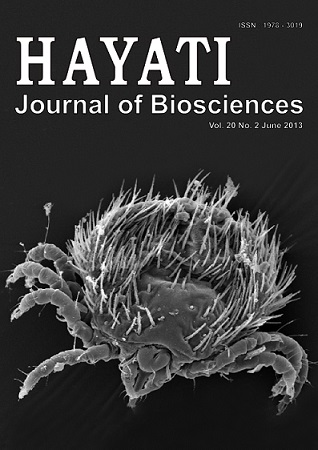Three Species of Ectoparasite Mites (Acari: Pterygosomatidae) Infested Geckos in Indonesia
Abstract
Limited data is hitherto available on the diversity and dispersal of parasitic mites of geckos in Indonesia. Here, we collected three species of geckos, namely Cosymbotus platyurus, Hemidactylus frenatus, and H. garnotii throughout Indonesia to study the distribution and diversity of its parasitic mites. We conducted detail morphological analysis of the mites using whole mount polyvinyl lactophenol and scanning electron microscope preparation. Three species of ectoparasite mites from genus Geckobia were identified in a total of 221 individuals out of 448 geckos collected from 25 sites in Indonesia. Two species were G. glebosum and G. bataviensis, and the other one was designated as Geckobia sp 1. Based on our result, the three mites species were spread randomly and live sympatrically. The G. bataviensis mite showed the widest distribution, because it was found in almost all gecko collection sites, hence the most cosmopolitan mites. We also found that C. platyurus gecko had the lowest mite prevalence which might due to the fact that it has the least number of skin folds, an important site for mite protection. This result implies that further research on the relationship of anatomy of gecko skin with chelicera and claw structure of mites is necessary in the future.Downloads
HAYATI J Biosci is an open access journal and the article's license is CC-BY-NC. This license lets others distribute, remix, tweak, and build upon author's work, as long as they credit the original creation. Authors retain copyright and grant the journal/publisher non exclusive publishing rights with the work simultaneously licensed under a https://creativecommons.org/

























.png) IPB University
IPB University Department of Biology
Department of Biology The Indonesian Biological Society
The Indonesian Biological Society 

